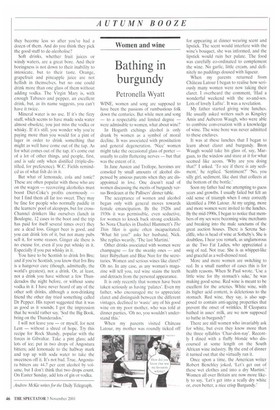Bathing in burgundy
Petronella Wyatt
WINE, women and song are supposed to have been the passions of rumbustious folk down the centuries. But while men and song — to a respectable and limited degree — were admissible to women, what about wine?
In Hogarth etchings alcohol is only drunk by women as a symbol of moral decline. It was associated with prostitution and general degeneration. 'Nice' women might take the occasional glass of porter — usually to calm fluttering nerves — but that was the extent of it.
In Jane Austen and Trollope, heroines are consoled by small amounts of alcohol dispensed by anxious parents when they are disappointed in love. One doesn't read of women discussing the merits of burgundy versus Bordeaux at the Pallisers' dinner table.
The acceptance of women and alcohol began only with general moves towards female emancipation. By the 1920s and 1930s it was permissible, even seductive, for women to knock back strong cocktails. So Nora Charles in Dashiel Hammett's The Thin Man is quite often incapacitated. 'What hit you?' asks her husband, Nick. She replies wearily, 'The last Martini.'
Other drinks associated with women were champagne — for the swanky ones — and later Babycham and Blue Nun for the secretaries. Women and serious wines like claret? Oh no. In any case, as any woman's magazine will tell you, red wine stains the teeth and detracts from the personal appearance.
It is only recently that women have been taken seriously as having 'palates'. Even my father, who encouraged me to appreciate claret and distinguish between the different vintages, declined to 'waste' any of his good wine on my poor mother, who was told at dinner parties, 'Oh no, you wouldn't understand this.'
When my parents visited Château Latour, my mother was roundly ticked off for appearing at dinner wearing scent and lipstick. The scent would interfere with the wine's bouquet, she was informed, and the lipstick would ruin her palate. The food was carefully co-ordinated to complement the wine. No garlic, little cream, and definitely no puddings doused with liqueur.
When my parents returned from Château Latour I began to realise how seriously many women were now taking their claret. I overheard the comment, 'Had a wonderful weekend with the so-and-sos. Lots of lovely Lafite'. It was a revelation.
My father started giving wine lunches. He usually asked writers such as Kingsley Amis and Auberon Waugh, who were able to combine conversation with a knowledge of wine. The wine bore was never admitted to these enclaves.
It was at these lunches that I began to learn about claret and burgundy. Bron Waugh would take his glass of, say, Margaux, to the window and stare at it for what seemed like aeons. 'Why are you doing that?' I asked. 'To see if there is any sediment,' he replied. `Sentiment?"No, you silly girl, sediment, like dust that collects at the bottom of the bottle.'
Soon my father had me attempting to guess years and growths. I usually failed but felt an odd sense of triumph when I once correctly identified a 1966 Latour. At my urging, more and more women were invited to the lunches. By the mid-1990s. I began to notice that members of my sex were becoming wine merchants and breaking into the male sanctums of the great auction houses. There is Serena Sutcliffe, who is head of wine at Sotheby's. She is doubtless, I hear you remark, as unglamorous as the Two Fat Ladies, who appreciated a swig of red. Not true. She is as whippet-like and graceful as a well-dressed reed.
More and more women are switching to red. In a small number of cases this is for health reasons. When St Paul wrote, 'Use a little wine for thy stomach's sake,' he was making good sense. Red wine is meant to be excellent for the arteries. White wine, with its higher acid content, is deleterious to the stomach. Red wine, they say, is also supposed to contain anti-ageing properties that prevent the onset of wrinkles. If Cleopatra bathed in asses' milk, are we now supposed to bathe in burgundy?
There are still women who invariably ask for white, but even they know more than the three syllables 'Char-don-nay'. Recently I dined with a fluffy blonde who discoursed at some length on the South African wine industry. By the end of dinner it turned out that she virtually ran it.
Once upon a time, the American writer Robert Benchley joked. 'Let's get out of these wet clothes and into a dry Martini.' Women all over Britain are now more likely to say, 'Let's get into a really dry white or, even better, a nice crisp Burgundy.'


















































































 Previous page
Previous page